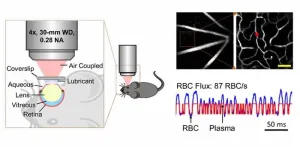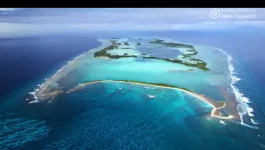(Press-News.org) The brain is one of the most metabolically active organs in the human body. Although it represents only about 2 percent of the human body’s weight, it receives 15 to 20 percent of the body’s total blood supply. Disrupted blood flow to the brain over a long period of time, a condition known as “chronic cerebral hypoperfusion” (CCH), can lead to serious cerebrovascular diseases such as white matter disease.
CCH manifests as lesions in the white matter, a brain region vulnerable to problems with blood supply. Unfortunately, CCH has no available cure. An early diagnosis by visualizing the microvascular changes in the brain that occur prior to lesion development is thus crucial. However, such a diagnosis is challenging with the available imaging techniques.
Conveniently, insights into the microvasculature of the brain may come from our eyes. The retina at the back of the eye is a peripheral part of the central nervous system and shares many similarities with cerebral brain matter. But it has fewer nerve cell types and a simpler structure, making it an excellent target for studying neural circuitry and neurovascular coupling.
In a recent study published in Neurophotonics, researchers from USA and China led by Baoqiang Li, Associate Professor at the Chinese Academy of Sciences, investigated whether blood flow in the retina at the microscopic level could be used to predict cerebrovascular diseases involving hypoperfusion. To test this hypothesis, the team developed an innovative imaging approach based on two-photon microscopy.
The researchers first induced CCH in mice by slightly blocking their carotid arteries. A week after, they studied one of their eyes directly under a two-photon microscope. The researchers observed and counted red blood cells (RBCs) circulating within individual capillaries in the retinal microvasculature of mice by labeling their blood plasma with a fluorescent tag.
The objective of these experiments was to quantify the flux of RBCs in as many capillaries as possible. Accordingly, the researchers compared their results with those of similar measurements made on cerebral gray and white matter in a previous study performed under similar experimental conditions.
Following careful statistical analysis, they found that the mean capillary RBC flux in the retina was more significantly affected by CCH than those in the white and gray matter. While the mean RBC flux decreased by 56 percent in the retina of CCH mice compared to that in normal mice, the corresponding reductions were only 36 percent and 6 percent in their white and gray matter, respectively.
Overall, the findings of this study indicate that microcirculation in the retina could be a promising predictor of CCH, and potentially serve as an early diagnostic biomarker for cerebrovascular diseases. Moreover, the imaging approach developed by the researchers is efficient, has high signal quality, and can be implemented with a standard commercial two-photon microscope.
Neurophotonics Associate Editor Andy Shih of the Seattle Children’s Research Institute remarks, “Being able to image retinal vascular physiology in vivo without adaptive optics is innovative. The results from this study may encourage further application of conventional two-photon imaging to retinal research.”
Future research using the proposed imaging technique will enable scientists to better understand neural circuits and neurovascular coupling. It may also help save lives through earlier diagnoses of cerebrovascular diseases.
Read the Gold Open Access article by Li et al., “Differential reductions in the capillary red-blood-cell flux between retina and brain under chronic global hypoperfusion,” Neurophotonics 10(3), 035001 (2023), doi 10.1117/1.NPh.10.3.035001.
END
Eyeing the brain: Predicting cerebrovascular diseases with retinal imaging
New imaging approach reveals that changes in retinal microcirculation may indicate brain diseases that involve reduced blood flow
2023-06-14
ELSE PRESS RELEASES FROM THIS DATE:
Phone Menu Test Detects Who May Be at Risk of Alzheimer’s Disease
2023-06-14
A new study by investigators from Mass General Brigham has found that a brief, simulated task of navigating a phone menu can detect the earliest changes in daily functioning in people at risk of developing Alzheimer’s disease. Investigators found that an older adult’s performance on the test, which can be completed in a matter of minutes, was associated with the hallmarks of Alzheimer’s disease pathology, including amyloid and tau depositions in the brain. The findings, which were published in the Journal of Alzheimer’s Disease, could help inform prevention trials testing treatments for Alzheimer’s disease before ...
When local economic inequality is high, the rich tend to be more generous
2023-06-14
Rich individuals living in communities with greater levels of economic inequality tend to be more generous with charitable giving and prosocial behaviors, according to a study published June 14, 2023 in the open-access journal PLOS ONE by Joel H. Suss from the London School of Economics & Political Science and Bank of England, UK.
Many studies have attempted to assess whether the rich are more or less generous than the poor, and whether this shifts depending on the starkness of economic inequality. Thus far, the results have been inconclusive. Previous work in this vein has been conducted at a macro level, using state, region, and country-level aggregated data. In this study, Suss ...
Ocean current comes to the rescue for Pacific island reefs
2023-06-14
Marine heatwaves are emerging as a key impact of climate change and pose a particularly significant threat to corals that form the backbone of coral reefs. Researchers have now identified a phenomenon that could help coral reef managers better plan and act for the future.[1]
Every few years, the cyclic climate pattern called El Niño arises in the tropical Pacific, causing significant changes in winds, weather and ocean temperatures. From April 2015 to May 2016, the Central Pacific witnessed one of the strongest El Niño events ever recorded.
Coral reefs were so stressed by the warmer ocean temperatures that they experienced mass bleaching, whereby the ...
'Smart' drugs can decrease productivity in people who don't have ADHD, study finds
2023-06-14
New research from the University of Cambridge and the University of Melbourne, published in Science Advances, shows neurotypical workers and students taking cognitive enhancers, or ‘smart’ drugs, may actually be inhibiting their performance and productivity.
Drugs such as methylphenidate, sold under the brand name Ritalin among others, are commonly prescribed for attention deficit hyperactivity disorder (ADHD), but are also taken by those without a diagnosis, in the belief that the drugs will enhance focus and cognitive performance.
In four double-blinded, ...
The mutant origin of brain aneurysms and the first drug treatment
2023-06-14
Researchers at the RIKEN Center for Brain Science (CBS) in Japan have discovered a set of related mutations that lead to intracranial aneurysms—weakened blood vessels in the brain that can burst at any time. The mutations all appear to act on the same biological signaling pathway, and the researchers report the first ever pharmaceutical treatment in a mouse model, which works by blocking this signal. The study was published in Science Translational Medicine on June 14.
About 5% of the population have unruptured intracranial aneurysms in blood vessels on the surface of the brain. Despite being ballooned arteries with ...
Massive hemorrhages are often deadly. Can a perfume ingredient stop the bleed and save lives?
2023-06-14
The chances of surviving massive blood loss from a traumatic injury such as a gunshot wound are around 50 percent. To survive, a patient needs two things to happen quickly: a large infusion of blood and coagulation at the wound to stop the bleeding.
The problem is one of these solutions prevents the other. Introducing a large amount of blood to those suffering a massive hemorrhage impairs the blood’s ability to clot, a condition known as coagulopathy.
Now, Tulane University researchers have uncovered the cause of coagulopathy in trauma victims receiving a blood infusion. They also found that a synthetic compound ...
Altered gut bacteria may be early sign of Alzheimer’s disease
2023-06-14
People in the earliest stage of Alzheimer’s disease — after brain changes have begun but before cognitive symptoms become apparent — harbor an assortment of bacteria in their intestines that differs from the gut bacteria of healthy people, according to a study by researchers at Washington University School of Medicine in St. Louis.
The findings, published June 14 in Science Translational Medicine, open up the possibility of analyzing the gut bacterial community to identify people at higher risk of developing dementia, and of designing microbiome-altering preventive treatments to stave off cognitive decline.
“We don’t yet know ...
Elimination of type of bacteria suggests treatment for endometriosis
2023-06-14
A research group from the Graduate School of Medicine and iGCORE at Nagoya University in Japan, has discovered that using an antibiotic to target Fusobacterium reduced the formation of lesions associated with endometriosis, a gynecological disorder characterized by endometrial tissue usually found inside the uterus being found outside it. Their findings suggest an alternative treatment for this disorder. The study was published in Science Translational Medicine.
Endometriosis affects one in ten women between the ages of 15 and 49. The disorder can cause lifelong health problems, including pelvic pain and infertility. ...
Newly planted vegetation accelerates dune erosion during extreme storms, research shows
2023-06-14
CORVALLIS, Ore. – Newly planted vegetation on coastal sand dunes can accelerate erosion from extreme waves, a study involving researchers from the Oregon State University College of Engineering suggests.
The authors note the findings run counter to the widely accepted paradigm that vegetation always acts to reduce erosion on dunes, the first line of storm defense for landscapes that are among the world’s most ecologically important and economically valuable.
The experiments involved building beach dune profiles 70 meters long and 4.5 meters high and subjecting ...
Preserving forests to protect deep soil from warming
2023-06-14
A recent study led by scientists at Lawrence Berkeley National Laboratory (Berkeley Lab) and the University of Zurich has revealed that the organic compounds proposed for carbon sequestration in deep soil are highly vulnerable to decomposition under global warming.
The finding has implications for a key strategy in carbon management that relies on soil and forests – natural carbon “sinks” – to mitigate global warming.
About 25 percent of global carbon emissions are captured by forests, grasslands, and rangelands. During photosynthesis, plants store carbon in their cell walls and in the soil. Because ...
LAST 30 PRESS RELEASES:
Magnetic avalanches power solar flares
LeapSpace goes live: the Research-Grade AI-Assisted Workspace built on trusted science
DNA tests reveal mysterious beluga family trees
Strategic sex: Alaska’s beluga whales swap mates for long-term survival
How early cell membranes may have shaped the origins of life
Cannabis legalization is driving increases in marijuana use among U.S. adults with historically lower consumption rates
Multifunctional dipoles enabling enhanced ionic and electronic transport for high‑energy batteries
Triboelectric nanogenerators for future space missions
Advancing energy development with MBene: Chemical mechanism, AI, and applications in energy storage and harvesting
Heteroatom‑coordinated Fe–N4 catalysts for enhanced oxygen reduction in alkaline seawater zinc‑air batteries
Meta-device for precision lateral displacement sensing
Plasma-guided mitotane for the treatment of adrenocortical carcinoma: adjuvant care to advanced disease
Theoretical study of laser-enhanced nuclear fusion reactions
Social environment impacts sleep quality
Optimized kinetic pathways of active hydrogen generation at Cu2O/Cu heterojunction interfaces to enhance nitrate electroreduction to ammonia
New design playbook could unlock next generation high energy lithium ion batteries
Drones reveal how feral horse units keep boundaries
New AI tool removes bottleneck in animal movement analysis
Bubble netting knowledge spread by immigrant humpback whales
Discovery of bats remarkable navigation strategy revealed in new study
Urban tributaries identified as major sources of plastic chemical pollution in the Yangtze River
UK glaucoma cases higher than expected and projected to reach 1.6 million+ by 2060
Type 2 diabetes prevention could more than halve carbon footprint linked to disease complications
Over 1 million estimated to have glaucoma in UK
Early treatment can delay rheumatoid arthritis for years
National childhood type 1 diabetes screening is effective and could prevent thousands of emergency diagnoses, UK study shows
Mix of different types of physical activity may be best for longer life
Continuous care from community-based midwives reduces risk of preterm birth by 45%
Otago experts propose fiber as first new essential nutrient in 50 years
Auburn Physics PhD student earns prestigious DOE Fellowship
[Press-News.org] Eyeing the brain: Predicting cerebrovascular diseases with retinal imagingNew imaging approach reveals that changes in retinal microcirculation may indicate brain diseases that involve reduced blood flow








